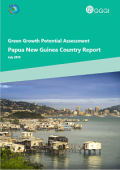This report presents the results of the testing of the GBEP indicators in Indonesia. The testing provided Indonesia with an understanding of how to establish the means of a long-term, periodic monitoring of its domestic bioenergy sector based on the GBEP indicators.
This is a roadmap to sustainable accommodation and MICE sectors in the Philippines, via resource-efficient and low-carbon development. Its vision is to enhance a globally recognized tourism destination that showcases and protects the natural beauty of the Philippines, the hospitality of its people and its cultural identity.

This case study builds on experiences shared by Africa Mini-Grids Community of Practice (AMG-CoP) members and further explores best practices for community engagement in the design and implementation of mini-grid projects. It draws particularly on recent activities in Nigeria and Sierra Leone.
This case study provides an updated overview of the European electricity sector transition, focusing on key topics like the growth in renewables, conventional power generation, electricity consumption, and CO₂ emissions. The case study also provides an overview of 2018 electricity consumption, generation and emissions by country with downloadable data for emissions by country to enable others to also perform up-to-date analysis.
This working paper details the results for both the total value of Dutch oil and gas reserves and the government appropriation of the resource rent from extraction. This is part of a larger effort by Eurostat to conduct valuations on sub-soil assets as part of their work to develop environmental accounts linked to national accounts. The methods and data presented in this paper can support both researchers and compilers of accounts for subsoil assets.
The Shandong Energy Efficiency and Emission Reduction Project supported by the Asian Development Bank (ADB) highlighted the impact of supporting the industry sector to invest in technology innovations that lead to reduced energy costs and enhanced market competitiveness.
The New Zealand Energy, Economy and Emissions Account (1997 - 2003) presents national and industry level information on energy demand, economic activity, and gas emissions for New Zealand. The industry level information contained in this report is important, as it provides the means to adapt policies to individual industries and activities.
The New Zealand Energy Monetary Stock Account (1987 - 2001) presents the environmental asset value of energy resources in New Zealand. The country’s energy resources include non-renewable resources (coal, gas, and oil) and renewable energy resources (biogas, biomass, geothermal energy, hydro energy, solar energy, and wind energy).
This case study, From Digging to Planting: A Sustainable Economic Transition for Berau, East Kalimantan, produced as part of Project LEOPALD or Low Emissions Oil Palm Development examines whether palm oil’s potential as an economic driver will bear out for Indonesia’s goals, using Berau as an example case.

This report, Green Growth Potential Assessment: Papua New Guinea country report presents the findings of the Green Growth Potential Assessment (GGPA) of Papua New Guinea and details the recommendations, each supported by a solid rationale and directly support achieving the goals set out in Papua New Guinea’s Vision 2050.
